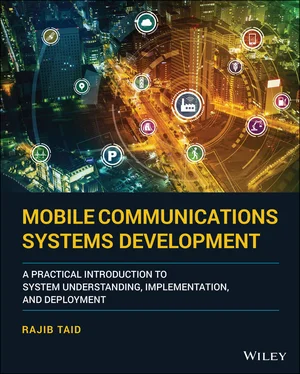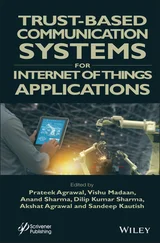5.7 LTE UE Application Protocol Identity
In the LTE/EPC system, the eNodeB and the MME exchanges control plane protocol messages over the S1 logical interface. Similarly, the eNodeBs exchange control plane protocol messages over the X2 logical interface. For unique identification of a UE over the S1 interface, the eNodeB and MME assign the eNB UE S1AP ID and MME UE S1AP ID , respectively, during the initial registration request made by the UE to the CN. The eNodeB and the MME include these identities in all the application protocol (S1AP) signaling messages that are exchanged between them for the particular UE following its initial registration request message.
For example, consider the LTE/EPS attach request message sent by the UE to MME. The eNodeB shall assign the eNB UE S1AP ID to identify the particular UE within the eNB and send it in the S1AP initialUEMessage to the MME. For more information on the definition of the initialUEMessage, refer to TS 36.413 [97].
The MME will also allocate the MME UE S1AP ID to identify the particular UE within the MME. From this instance onward, both the eNodeB and the MME shall include the respective S1AP identities in all the application protocol S1AP messages, e.g. Uplink/Downlink NAS Transport, exchanged between them on behalf of the particular UE. Similarly, the eNodeB assigns the eNB UE X2AP ID to identify a UE over the X2 interface. This identity is included in the X2AP messages exchanged between two eNodeBs.
In this chapter, we have presented some of the network identities of network elements of communications networks from the GSM to the LTE system. Network identities are common as well as specific to a particular communications system. An operator may allocate network identities permanently to a network element. On the other hand, a network element can also generate network element identities and allocates temporarily to another network element at runtime. Such a network identity may address MSs/UEs over the air interface for granting, assigning, and releasing of shared radio resources by the particular RAN. This chapter discussed the usages, length, and the value range of some of the network identities.
Network identities play a very important role in troubleshooting and resolving network services‐related issues. During an inter‐RAT movement of a user, a network identity in the target RAT can be derived from the identity used in the source RAT. A network identity may carry and be encoded with several individual information/components. Such individual component further provides network‐related information or another network element identity. For more information on the network identities described in this chapter as well as other network identities and their structures, the reader may further refer to the references mentioned at the end of this book, especially the TS 23.003 [30].
6 Interworking and Interoperations of Mobile Communications Networks
Introduction
This chapter covers one of the most important functionalities, that is, interworking and interoperation, through which mobile communications networks provide seamless communications services to subscribers. Interworking facilitates an operator to provide various communication services to its subscribers within its home network. We begin with the basic interworking among the Global System for Mobile Communication (GSM), General Packet Radio Service (GPRS), Universal Mobile Telecommunication System (UMTS), and Long‐Term Evolution (LTE)/Evolved Packet System (EPS) networks and show how it can be realized within a home network using upgraded/enhanced and legacy network elements. We then present the advanced interworking features through which an operator may provide voice call services to subscribers currently registered in an LTE/EPS network. Interworking between the LTE/EPS and the 5G system is also described briefly.
Interoperations facilitate the operators to provide various communications services to their roaming subscribers when traveling outside of the home network. Interoperation works through the interworking of networks of the same or different operators. We present the interoperation cases for roaming subscribers through a visiting network that deploys either upgraded/enhanced or legacy network elements. We then close this chapter with the methods of routing roaming user data to the external network.
6.1 Requirements and Types of Interworking
Figures 2.1– 2.4, in Section 2.1, provide the basic and introductory architecture of the mobile communications networks based on the GSM (2nd generation), UMTS (3rd generation), and the LTE (4th generation) systems. These architectures may be deployed individually by an operator to provide voice and data communication services to different categories of subscribers. For example, a subscriber may like to avail and subscribe to GSM service only; another subscriber may like to avail and subscribe to both the voice and data services through the UMTS network. Similarly, a subscriber may like to avail and subscribe voice call service through a UMTS network and mobile broadband services through an LTE/EPS network only. The different types of services that can be availed by a subscriber also depend on the capability of the mobile device. Within the same operator, a mobile user that is currently registered in an LTE/EPS network may move to a different part of the same city having UMTS coverage only. In this case, the User Equipment (UE) will access and register with the UMTS network and continue providing the communication services to the subscriber.
From the above examples, it appears that the mobile communications networks must have the capability and flexibility to provide communications services as per the mobilities and requirements of the subscribers are concerned. The UE/Mobile station (MS), access network, and circuit‐switched (CS) and packet‐switched (PS) domain core network elements of the GSM, GPRS, UMTS, and LTE networks provide such communications services through interworking among them.
Interworking of a mobile communications network can take place with the following types of networks:
Traditional Public Switched Telephone Network (PSTN), as shown in Figures 2.1and 2.3, connecting the GSM and UMTS Release 99 network with the PSTN.
External IP data network, e.g. Internet, as shown in Figures 2.2, 2.3, and 2.13, connecting the GPRS and UMTS Release 99 network with the Internet.
Packet domain communications networks.
Interworking among the networks is realized through a particular logical interface that connects their gateway or anchoring network element. For example, in Figures 2.2and 2.3, GPRS and UMTS PS core network is connected with the Internet through the Gi interface. Similarly, in Figure 2.4, the LTE/Evolved Packet Core (EPC) network is connected with the Internet through the SGi interface.
In the next sections, we will discuss the interworking among the packet domain communications networks, i.e. LTE/EPS, GPRS, and UMTS networks. The interworking of these networks can be realized in the following ways:
Interworking through enhanced network elements
Interworking through legacy network elements
6.2 Interworking Through Enhanced Network Elements
It was mentioned in Section 2.3.2that the legacy GPRS and UMTS PS core network element Serving GPRS Support Node (SGSN) exists in LTE/EPC network also. The SGSN is the central interworking network element for the LTE/EPC, GPRS, and UMTS PS domain core networks. Functionality wise, the LTE/EPC SGSN was upgraded to support interworking and mobility management capabilities between the LTE/EPC and GPRS/UMTS PS domain networks. This is in addition to the legacy functions that are performed by the SGSN for a GPRS and UMTS network. A scenario where the GSM, GPRS, UMTS, and LTE networks may be deployed by an operator through their interworking can be found in Figure 1(b) TS 23.002 [29].
Читать дальше












